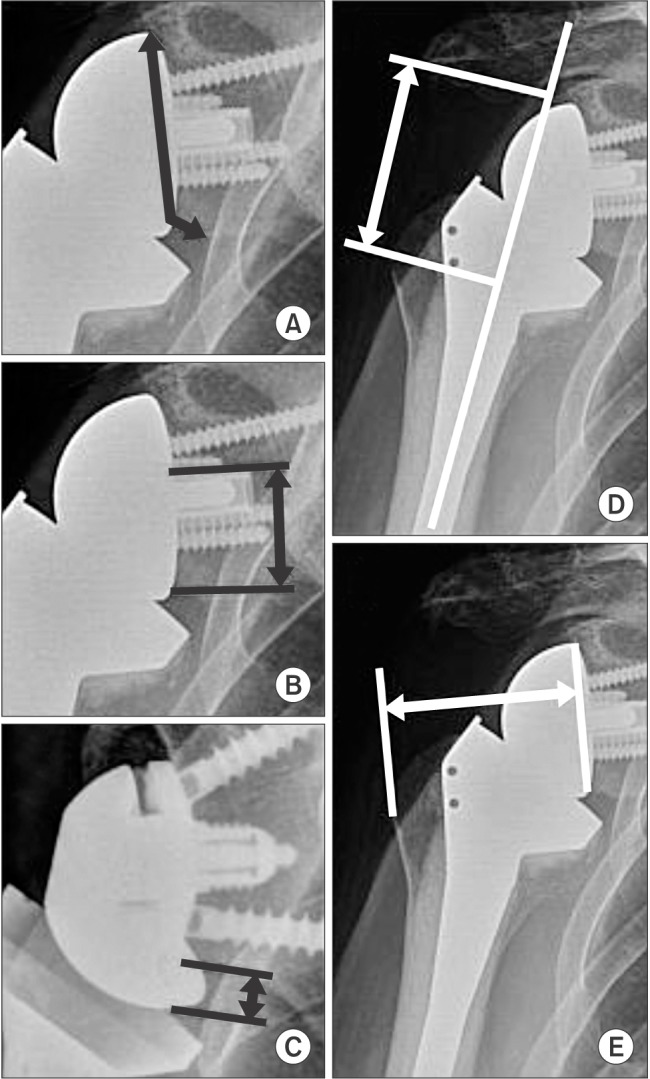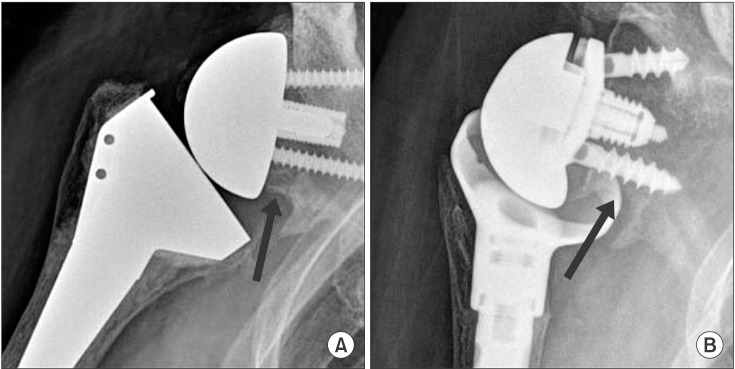Clin Orthop Surg.
2017 Mar;9(1):83-90. 10.4055/cios.2017.9.1.83.
Comparison of Clinical and Radiological Results according to Glenosphere Position in Reverse Total Shoulder Arthroplasty: A Short-term Follow-up Study
- Affiliations
-
- 1Shoulder and Elbow Joint Service, Department of Orthopaedic Surgery, Daegu Catholic University Medical Center, Daegu, Korea. kwackbyunghoon@nate.com
- KMID: 2412308
- DOI: http://doi.org/10.4055/cios.2017.9.1.83
Abstract
- BACKGROUND
In a previous biomechanical study, eccentric glenospheres with more inferior position of the center of rotation were shown to improve range of motion and reduce the incidence of scapular notching after reverse total shoulder arthroplasty (RSA). The purpose of this study was to compare the clinical and radiological results of RSA using an eccentric glenosphere to those using a concentric glenosphere and to determine the usefulness of the eccentric glenosphere.
METHODS
From 2009 to 2015, we performed a retrospective review of 20 consecutive patients who underwent RSA using a deltopectoral approach. Nine patients underwent RSA using a concentric glenosphere (group A) while 11 had an eccentric glenosphere (group B). The average follow-up period was 13.9 months (range, 12 to 18 months). All glenoid components were placed with 15° of inferior tilt. Clinical results were assessed using the visual analog pain scale score (VAS), the American Shoulder and Elbow Surgeon (ASES) score, the Korean shoulder scoring system (KSS), and the Constant score. On radiological evaluation, prosthesisscapular neck angle (PSNA), peg-glenoid rim distance (PGRD), scapular neck-inferior glenoshere rim distance (inferior glenoshpere overhang), acromion-greater tuberosity (AT) distance, glenoid-greater tuberosity (GT) distance, and severity of notching according to the Nerot-Sirveaux classification were assessed.
RESULTS
The clinical results improved significantly in both groups, but there was no statistically significant difference between the two groups. A significant intergroup difference was observed with regard to PGRD (24.8 ± 1.6 mm for group A vs. 22.2 ± 1.9 mm for group B; p = 0.002) and inferior glenosphere overhang (2.0 ± 1.7 mm for group A vs. 5.8 ± 1.6 mm for group B; p = 0.000). Seven of 9 patients in group A developed notching compared with 2 of 11 patients in group B (p = 0.022). The other radiological parameters such as inferior tilt and AT and GT distances were not significantly different between two groups. Complications such as loosening and scapular fractures did not occur.
CONCLUSIONS
The eccentric glenosphere in RSA was more effective in reducing the rate of notching than the concentric glenosphere although clinical outcomes were not significantly different in the short-term follow-up.
Keyword
MeSH Terms
-
Aged
Arthroplasty, Replacement, Shoulder/adverse effects/instrumentation/*methods
Biomechanical Phenomena
Female
Follow-Up Studies
Humans
Male
Middle Aged
Pain Measurement
Pain, Postoperative/etiology
Radiography
Range of Motion, Articular
Retrospective Studies
Rotator Cuff Injuries/complications/*surgery
Shoulder Joint/*diagnostic imaging/*physiopathology/surgery
Shoulder Pain/etiology
Shoulder Prosthesis
Time Factors
Figure
Reference
-
1. Grammont P, Trouilloud P, Laffay J, Deries X. Concept study and realization of a new total shoulder prosthesis. Rhumatologie. 1987; 39:407–418.2. Simovitch RW, Zumstein MA, Lohri E, Helmy N, Gerber C. Predictors of scapular notching in patients managed with the Delta III reverse total shoulder replacement. J Bone Joint Surg Am. 2007; 89(3):588–600. PMID: 17332108.
Article3. Werner CM, Steinmann PA, Gilbart M, Gerber C. Treatment of painful pseudoparesis due to irreparable rotator cuff dysfunction with the Delta III reverse-ball-and-socket total shoulder prosthesis. J Bone Joint Surg Am. 2005; 87(7):1476–1486. PMID: 15995114.
Article4. de Wilde LF, Poncet D, Middernacht B, Ekelund A. Prosthetic overhang is the most effective way to prevent scapular conflict in a reverse total shoulder prosthesis. Acta Orthop. 2010; 81(6):719–726. PMID: 21110704.
Article5. Nyffeler RW, Werner CM, Gerber C. Biomechanical relevance of glenoid component positioning in the reverse Delta III total shoulder prosthesis. J Shoulder Elbow Surg. 2005; 14(5):524–528. PMID: 16194746.
Article6. Gutierrez S, Comiskey CA 4th, Luo ZP, Pupello DR, Frankle MA. Range of impingement-free abduction and adduction deficit after reverse shoulder arthroplasty: hierarchy of surgical and implant-design-related factors. J Bone Joint Surg Am. 2008; 90(12):2606–2615. PMID: 19047705.7. Stephenson DR, Oh JH, McGarry MH, Rick Hatch GF 3rd, Lee TQ. Effect of humeral component version on impingement in reverse total shoulder arthroplasty. J Shoulder Elbow Surg. 2011; 20(4):652–658. PMID: 21144775.
Article8. Michener LA, McClure PW, Sennett BJ. American Shoulder and Elbow Surgeons Standardized Shoulder Assessment Form, patient self-report section: reliability, validity, and responsiveness. J Shoulder Elbow Surg. 2002; 11(6):587–594. PMID: 12469084.
Article9. Tae SK, Rhee YG, Park TS, et al. The development and validation of an appraisal method for rotator cuff disorders: the Korean Shoulder Scoring System. J Shoulder Elbow Surg. 2009; 18(5):689–696. PMID: 19278871.
Article10. Constant CR, Murley AH. A clinical method of functional assessment of the shoulder. Clin Orthop Relat Res. 1987; (214):160–164. PMID: 3791738.
Article11. De Biase CF, Delcogliano M, Borroni M, Castagna A. Reverse total shoulder arthroplasty: radiological and clinical result using an eccentric glenosphere. Musculoskelet Surg. 2012; 96(Suppl 1):S27–S34. PMID: 22528848.
Article12. Otto RJ, Virani NA, Levy JC, Nigro PT, Cuff DJ, Frankle MA. Scapular fractures after reverse shoulder arthroplasty: evaluation of risk factors and the reliability of a proposed classification. J Shoulder Elbow Surg. 2013; 22(11):1514–1521. PMID: 23659805.
Article13. Sirveaux F, Favard L, Oudet D, Huquet D, Walch G, Mole D. Grammont inverted total shoulder arthroplasty in the treatment of glenohumeral osteoarthritis with massive rupture of the cuff: results of a multicentre study of 80 shoulders. J Bone Joint Surg Br. 2004; 86(3):388–395. PMID: 15125127.14. Mizuno N, Denard PJ, Raiss P, Walch G. The clinical and radiographical results of reverse total shoulder arthroplasty with eccentric glenosphere. Int Orthop. 2012; 36(8):1647–1653. PMID: 22534957.
Article15. Poon PC, Chou J, Young SW, Astley T. A comparison of concentric and eccentric glenospheres in reverse shoulder arthroplasty: a randomized controlled trial. J Bone Joint Surg Am. 2014; 96(16):e138. PMID: 25143506.16. Gutierrez S, Greiwe RM, Frankle MA, Siegal S, Lee WE 3rd. Biomechanical comparison of component position and hardware failure in the reverse shoulder prosthesis. J Shoulder Elbow Surg. 2007; 16(3 Suppl):S9–S12. PMID: 16990024.17. Edwards TB, Trappey GJ, Riley C, O'Connor DP, Elkousy HA, Gartsman GM. Inferior tilt of the glenoid component does not decrease scapular notching in reverse shoulder arthroplasty: results of a prospective randomized study. J Shoulder Elbow Surg. 2012; 21(5):641–646. PMID: 22079769.
Article18. Roche CP, Diep P, Hamilton MA, Flurin PH, Routman HD. Comparison of bone removed with reverse total shoulder arthroplasty. Bull Hosp Jt Dis (2013). 2013; 71(Suppl 2):S36–S40. PMID: 24328578.19. Chou J, Malak SF, Anderson IA, Astley T, Poon PC. Biomechanical evaluation of different designs of glenospheres in the SMR reverse total shoulder prosthesis: range of motion and risk of scapular notching. J Shoulder Elbow Surg. 2009; 18(3):354–359. PMID: 19393929.
Article20. Debeer P, Robyns F. Fracture of the scapular spine in a patient with a Delta III prosthesis. Acta Orthop Belg. 2005; 71(5):612–614. PMID: 16305089.
- Full Text Links
- Actions
-
Cited
- CITED
-
- Close
- Share
- Similar articles
-
- Difference in the Surgical Approach in Reverse Total Shoulder Arthroplasty for Cuff Tear Arthroplasty: Comparison of the Radiological and Clinical Result according to the Deltopectoral and Anterosuperior Approach
- Reverse Total Shoulder Arthroplasty: Complications
- Isolated Musculocutaneous Nerve Palsy after the Reverse Total Shoulder Arthroplasty
- The Primary Reverse Total Shoulder Arthroplasty for Post-septic Destroyed Shoulder: A Case Report
- Reverse Total Shoulder Arthroplasty: Techniques and Pitfalls



